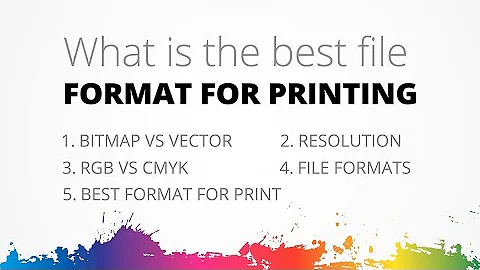What is the highest quality image format for printing?
When printing raster images, RAW file formats usually offer the best resolution. Unfortunately, there are many printers out there that don't accept such a large and uncompressed file. Alternatively, some printers use TIFF/TIF, a file format popular in the photography and publishing industries.
TIFF is the workhorse format for high-resolution printing, including art photography and other fine artwork. It's a lossless image file format that retains extremely high photographic quality for scanning and printing.
Recommended minimum resolution for printing is 300 DPI; computer monitors generally have a display setting of 72 DPI or 96 DPI.
JPG vs PNG for Printing
PNG's high-resolution images offer superior color depth and can deliver high-quality prints on home or industrial printers. Meanwhile, lossy compression could make JPG photos become blurry or lose color when they're printed.
This is the largest and most detailed photo ever taken of a work of art. It is 717 gigapixels, or 717,000,000,000 pixels, in size. The distance between two pixels is 5 micrometres (0.005 millimetre), which means that one pixel is smaller than a human red blood cell.
JPEG/JFIF supports a maximum image size of 65,535×65,535 pixels, hence up to 4 gigapixels for an aspect ratio of 1:1.
JPEG files are very common on the Internet and JPEG is a popular format for digital cameras - making it ideal for web use and non-professional prints.
PNG is a high-quality graphics format – generally higher in quality than JPEGs, which are compressed to save space. The PNG format uses lossless compression and is generally considered a replacement to the Graphics Interchange Format (GIF format).
DPI stands for dots per square inch. A 300 DPI image is considered to be a high quality photo for print.
So, when it comes to printing, know that PNG files are an excellent option for delivering good quality printouts using office or home printers. This is because these files contain high-resolution images and better color depth. Images from JPEG files become blurry in printouts.
Is PDF or PNG better for printing?
Is PDF or PNG better for printing? For printing, PDF images are recommended. PDF files are also an excellent choice for flyers, posters, magazines, and storing images online. If you are planning to edit and save your file multiple times, PNG is the proper file type for this.
PDFs will often be higher quality than JPEGs. This is because JPEGs compress images, leading to a loss in quality that you can't regain. Visuals saved as PDF are of very high quality and even customizable, making them the file format of choice for printers.

How can I check if my photo is hi-res? On your computer, right-click on the image and then select “Properties.” A window will appear with the image's details. Go to the “Details” tab to see the image's dimensions and resolution. Resolution should be at least 300 PPI or 300 DPI to be considered hi-res.
Higher resolutions mean that there more pixels per inch (PPI), resulting in more pixel information and creating a high-quality, crisp image. Images with lower resolutions have fewer pixels, and if those few pixels are too large (usually when an image is stretched), they can become visible like the image below.
To convert a picture to high resolution, you can use an image upscaling tool like Upscale.media. Upscaling is a process that increases the size and resolution of an image while trying to maintain its quality. Yes, a JPEG can be high resolution.
What is higher quality, PNG or PDF? In general, PNG offers higher image quality than PDF. PNG files support a wide range of color and can easily be compressed without losing quality.
Generally, a RAW file will be between two and six times larger than a JPEG file. RAW files are bigger because they contain a much greater amount of image data.
The PNG, JPEG, and GIF formats are most often used to display images on the Internet. Some of these graphic formats are listed and briefly described below, separated into the two main families of graphics: raster and vector.
Which file is best for photography — JPEG or TIFF? A TIFF will enable you to store richer, more detailed images. It's good practice to save your original (or source) photos as TIFF files. JPEGs, meanwhile, might be a better choice for exporting your finished edits because they're easier to share and print.
A high-quality PNG resolution is typically 300 pixels per inch (ppi).
What is higher quality PNG or TIFF?
Are PNG or TIFF files better for photos? TIFF files are better for print photography while PNGs work best for screens. Neither option, however, is ideal for web use due to their large file size.
In contrast, PNG files benefit from lossless compression. This means no data is lost when the image is compressed — the quality stays the same no matter how many times you edit and save the file. The image won't become blurry or distorted, making PNGs ideal for sharp logos and graphs containing lots of figures.
The best resolution for printing is 300 PPI with placed images at 100% or smaller. Increasing the size of an image will lower its final PPI. At 300 PPI, an image will appear sharp and crisp. This is considered to be high resolution or high-res.
Any image with fewer than 300 pixels per inch is considered as a low-resolution image. 72 PPI is standard for the Internet; the lower the number of pixels, the smaller the file size and the faster it will load. However, the low pixel count is not the only factor that makes an image's resolution low.
A good quality print will require a resolution of 900 x 1260 pixels. For a better-quality print, use 1200 x 1680 pixels. Finally, for the best quality, you should go with 1500 x 2100 pixels.